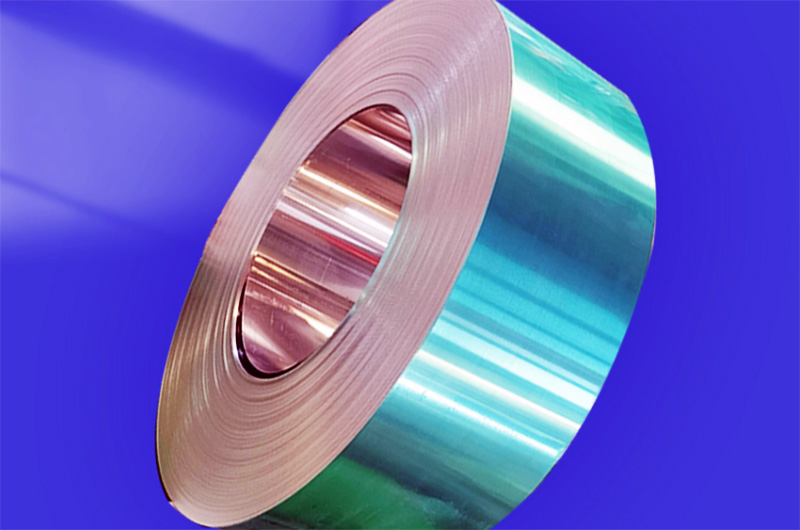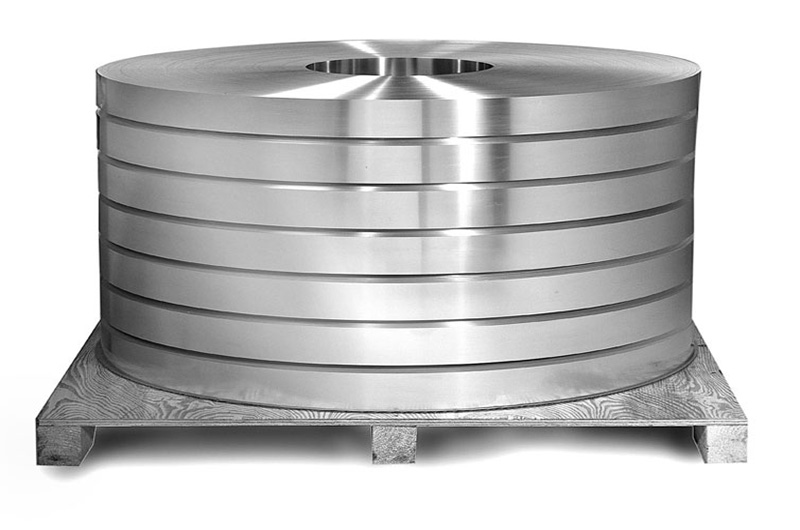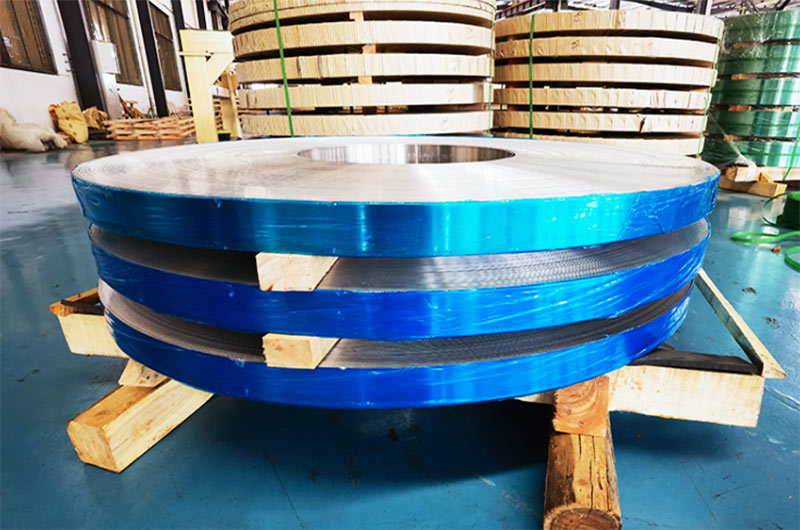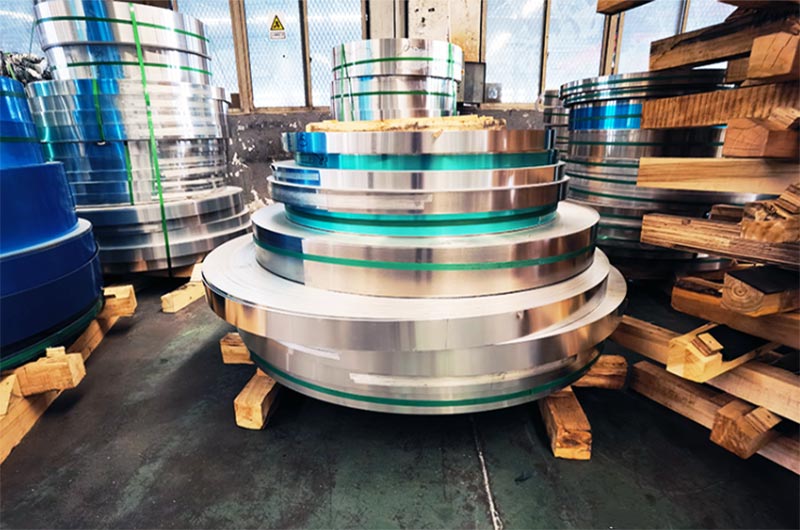- What is a Transformer Aluminum Strip?
- Advantages of Transformer Aluminum Strip
- Transformer Aluminum Strip Specifications
- Transformer Aluminum Strip has Stable Performance
- Transformer Aluminum Strip Application
- Frequently Asked Questions about the Transformer Aluminum Strip
- Aluminum Transformer vs Copper Wound Transformer
- Aluminum strip production process for transformers
- The Following Factors Need to be Considered When Choosing Transformer Aluminum Strip
What is a Transformer Aluminum Strip?
Transformer aluminum strip refers to a type of aluminum strip specially designed for transformer windings. It is a flat and narrow aluminum material obtained by rolling aluminum ingots, and is a key component of power transformer windings and core assemblies.
Transformer aluminum strip is one of the key materials used to manufacture transformers, and it usually exists in the form of aluminum alloy. This aluminum strip plays an important role in the power industry, especially in the manufacture of power transformers.

Aluminum strips in transformers are often used as conductors to carry electrical current. Aluminum is often chosen for its conductivity, lightweight and cost-effectiveness. It is commonly found in the windings of transformers and helps efficiently transfer electrical energy from one circuit to another.
Aluminum tape for transformer winding, also known as aluminum foil tape for transformers, is widely used in the production of dry-type transformers, oil-immersed transformers, high and low voltage transformers, etc.
Transformer strip is made of high-purity aluminum, which is highly conductive and ideal for use in high-voltage windings of transformers. There are many types according to different uses:
- 1050 Transformer Aluminium Strip
- 1050A Transformer Aluminium Strip
- 1060 Transformer Aluminium Strip
- 1070 Transformer Aluminium Strip
- 1070A Transformer Aluminium Strip
- 1350 Transformer Aluminium Strip
Aluminum is an excellent conductive material. Although its conductivity is slightly inferior to copper, it is widely used in the power industry due to its light weight and low cost. The conductive properties of transformer aluminum strips are sufficient to meet the requirements of power transmission and transformers.
| Alloy | Conductivity |
|---|---|
| 1050 Transformer Aluminium Strip | 60%IACS |
| 1060 Transformer Aluminium Strip | 61.5%IACS |
| 1070 Transformer Aluminium Strip | 62.7%IACS |
| 1350 Transformer Aluminium Strip | 60%IACS |
| 3003 Transformer Aluminium Strip | 60%IACS |
| 5052 Transformer Aluminium Strip | 52%IACS |
The transformer will generate a certain amount of heat during operation, and good thermal conductivity is another key feature of the transformer aluminum strip. It helps dissipate heat and keep the transformer within normal operating temperature range.
| Alloy | Resistivity |
|---|---|
| 1060 Transformer Aluminium Strip | 2.82*10^-8Ω.m |
| 1070 Transformer Aluminium Strip | 2.82*10^-8Ω.m |
| 1350 Transformer Aluminium Strip | 2.82*10^-8Ω.m |
| 3003 Transformer Aluminium Strip | 2.75*10^-8Ω.m |
| 5052 Transformer Aluminium Strip | 3.12*10^-8Ω.m |
1050 Transformer Aluminium Strip
- Alloy 1050 is a commercially pure aluminum alloy with excellent electrical conductivity. It's used in applications that require high electrical conductivity and where mechanical strength is not a primary concern.
- In transformers, 1050 aluminum strips might be used in low-voltage and low-power applications.
| Element | Chemical Composition (% by weight) |
|---|---|
| Aluminum (Al) | ≥ 99.50% |
| Other Elements | ≤ 0.25% |

1060 Transformer Aluminium Strip
- Alloy 1060 is also a pure aluminum alloy with similar properties to 1050. It has high electrical conductivity and good formability.
- 1060 aluminum strips might be used in transformer windings where moderate electrical conductivity is required.
| Element | Chemical Composition (% by weight) |
|---|---|
| Aluminum (Al) | ≥ 99.60% |
| Other Elements | ≤ 0.25% |
1070 Transformer Aluminium Strip
- Alloy 1070 is another pure aluminum alloy that offers high electrical conductivity.
- It's commonly used in applications where electrical conductivity is crucial, such as electrical conductors and transformer windings.
| Element | Chemical Composition (% by weight) |
|---|---|
| Aluminum (Al) | ≥ 99.70% |
| Other Elements | ≤ 0.25% |

1350 Transformer Aluminium Strip
- Alloy 1350 is an aluminum alloy with very high electrical conductivity.
- It's often used in applications where electrical performance is critical. In transformer windings, 1350 aluminum strips might be used in high-efficiency and high-performance transformers.
| Element | Chemical Composition (% by weight) |
|---|---|
| Aluminum (Al) | ≥ 99.50% |
| Other Elements | ≤ 0.10% |
Advantages of Transformer Aluminum Strip
Transformer aluminum strip offers several advantages over other materials such as copper, making it a suitable replacement for copper in certain transformer applications.
- 1. High conductivity, soft quality, smooth surface, no burrs
- 2. It is lighter and therefore easier to handle and transport.
- 3. Transformer aluminum strip has good thermal conductivity, which helps to dissipate the heat generated by the transformer.
- 4. Aluminum is generally less expensive than copper and has a lower density, making transformers with aluminum windings lighter.
Although aluminum has a lower electrical conductivity than copper, proper design and larger cross-sections can compensate for the difference in electrical performance.

Transformer Aluminum Strip Specifications
- Alloys : 1050, 1060, 1070, 1350, 3003, 5052.
- Thickness : generally between 0.2-4mm, the specific thickness should be determined according to the power of the transformer and the use environment.
- Width : According to different transformer models and capacities, the width is generally between 20-2000mm.
- Wire diameter : determined according to the winding design of the transformer and the environment in which it is used.
- Number of wires : Determined according to the winding design of the transformer and the environment in which it is used.
- Surface treatment : Anti-rust treatment, painting treatment, sandblasting treatment, etc. can be carried out to ensure the quality and durability of the surface of the aluminum strip.
Transformer Aluminum Strip has Stable Performance
Haomei Aluminum to ensure the quality of Transformer Aluminum Strip is controlled and managed from various aspects
- Material control : select high-quality raw materials and ensure that they meet the requirements of standards and specifications. Select high-purity aluminum or suitable aluminum alloy, and conduct chemical composition analysis, physical performance test, etc.
- Manufacturing process control : Appropriate technology should be used in the manufacturing process to ensure that the size, surface quality, and performance of the Strip meet the requirements. Adopt precise rolling process and surface treatment process to ensure the dimensional accuracy and surface flatness of Strip.
- Quality inspection control : Carry out quality inspection on the manufactured Strip, including appearance inspection, dimension inspection, performance test, etc. Strip surface and internal quality is inspected using X-ray or ultrasonic inspection techniques.
- Quality management system : Implement a strict quality management system to ensure that all production links meet the requirements of quality standards and specifications, and promptly correct any quality problems.
- Customer feedback and improvement : collect and analyze customer feedback, and take timely measures to improve the quality and performance of Strip to meet customer needs.

Transformer Aluminum Strip Application
Transformer Aluminum Strips are primarily used for constructing the winding coils and the core of various types of transformers, including power transformers, distribution transformers, and more.
| Transformer Aluminium Strip | Application |
|---|---|
| 1060/3003 | Small transformers, inductors, AC motors and electrical equipment |
| 1070 | Small and medium-sized transformers, inductors and electrical equipment |
| 1350/5052 | Large high-voltage transformers, power transmission lines |
Transformer aluminum strip is used in a variety of transformers, including power transformers, distribution transformers and instrument transformers. It is also used in other electrical equipment such as electric motors and generators.
Transformer aluminum strips can make dry-type transformers small in size, light in weight, good in insulation performance, flame retardant, pollution-free, small in partial discharge, resistant to moisture, stable and reliable in operation, and low in noise. They are used in high-rise buildings, underground facilities, commercial centers, and residential areas. It is widely used in hotels, restaurants and coastal humid areas.
Frequently Asked Questions about the Transformer Aluminum Strip
How is the Thickness of Transformer Aluminum Strips Determined?
The thickness of the strips is chosen based on the design specifications of the transformer, including factors like the voltage rating, current capacity, and efficiency requirements.
How is the Insulation of Transformer Aluminum Strips Handled?
Transformer Aluminum Strips may be coated with insulating materials to prevent short circuits and ensure proper electrical isolation between winding layers. Common insulating coatings include enamel, paper, and varnish.
Can Transformer Aluminum Strips be Recycled?
Yes, aluminum is highly recyclable, and the strips can be recycled to reclaim the metal for other applications. Recycling aluminum requires less energy compared to producing it from raw materials.

Aluminum Transformer vs Copper Wound Transformer
The main difference between aluminum wound transformers and copper wound transformers is the material used for the windings. In aluminum wound transformers, the windings are made of aluminum wires, while in copper wound transformers, the windings are made of copper wires.
- Electrical conductivity : Copper has a higher electrical conductivity than aluminum, which means that copper-wound transformers are more efficient than aluminum-wound transformers.
- Cost : Copper is more expensive than aluminum, so copper-wound transformers are generally more expensive to manufacture than aluminum-wound transformers.
- Weight : Aluminum is lighter than copper, so aluminum-wound transformers weigh less than copper-wound transformers. This can be an advantage in some applications where weight is a concern.
- Thermal expansion : Aluminum has a higher coefficient of thermal expansion than copper, which means that aluminum-wound transformers may experience more thermal expansion and contraction during operation. This can cause mechanical stress and shorten the life of the transformer.
- Corrosion resistance : Copper is more resistant to corrosion than aluminum, which means that copper-wound transformers may be better suited for use in harsh environments.
Copper-wound transformers are generally more efficient, but are more expensive, heavier and less suitable for harsh environments.
Aluminum-wound transformers are lighter and less expensive, but may be less efficient and less suitable for use in environments with high corrosion or thermal stress.
Aluminum strip production process for transformers
Transformer aluminum strips are usually made of high-purity aluminum alloy to ensure their electrical and thermal conductivity. The manufacturing process typically includes steps such as casting, rolling and drawing to obtain the required dimensions and properties.
The first step: cutting the original fabric
The raw aluminum coil fabric is made into the width required by the customer through slitting equipment.
2: Aluminum coil winding
Therefore, to ensure the quality of aluminum coils, the remedial measure is to perform it on the equipment
Third: Aluminum coil constant
The aluminum coil detection width and thickness deviation are consistent with the customer's technical requirements, the reel is added with a paper sleeve, and the aluminum coil is connected with a fiberglass tape
The Following Factors Need to be Considered When Choosing Transformer Aluminum Strip
As an important material for transformers, it has high requirements on many technical indicators such as conductivity, burr curling, side bending, and surface quality.
- Size requirements : first determine the size and thickness of the required Strip. This usually depends on the design and specification of the transformer. Strips should be selected with the required size and thickness to ensure that the strip matches the rest of the transformer.
- Alloy quality : It is also important to choose the appropriate alloy quality. Transformer Aluminum Strip mainly uses aluminum and aluminum alloys. Different alloys have different properties and characteristics, such as strength, electrical conductivity, corrosion resistance, weldability, etc. It is necessary to select the appropriate alloy quality according to actual needs.
- Surface quality : The surface quality of the Strip is also very important. Surface defects, oxide layers, cracks, etc. may affect the performance and life of Strip. Therefore, a strip with a smooth surface, no cracks, and no oxide layer should be selected.
- Quality Certification : It is also important to choose a Strip with quality certification. For example, Strip conforming to ASTM, IEC, GB and other standards and specifications can ensure that the quality and performance of Strip meet the requirements.
- Supplier Reputation and Experience : Lastly, it is also very important to choose a supplier with good reputation and extensive experience. Suppliers should be able to provide strips that meet the requirements, and have the ability to respond quickly and provide high-quality services.
